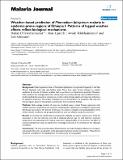| dc.contributor.author | Teklehaimanot, Hailay D | |
| dc.contributor.author | Teklehaimanot, Awash | |
| dc.contributor.author | Lipsitch, Marc | |
| dc.contributor.author | Schwartz, Joel David | |
| dc.date.accessioned | 2011-05-15T21:58:23Z | |
| dc.date.issued | 2004 | |
| dc.identifier.citation | Teklehaimanot, Hailay D., Marc Lipsitch, Awash Teklehaimanot, and Joel Schwartz. 2004. Weather-based prediction of Plasmodium falciparum malaria in epidemic-prone regions of Ethiopia I. Patterns of lagged weather effects reflect biological mechanisms. Malaria Journal 3: 41. | en_US |
| dc.identifier.issn | 1475-2875 | en_US |
| dc.identifier.uri | http://nrs.harvard.edu/urn-3:HUL.InstRepos:4889512 | |
| dc.description.abstract | Background: Malaria epidemics due to Plasmodium falciparum are reported frequently in the East African highlands with high case fatality rates. There have been formal attempts to predict epidemics by the use of climatic variables that are predictors of transmission potential. However, little consensus has emerged about the relative importance and predictive value of different factors. Understanding the reasons for variation is crucial to determining specific and important indicators for epidemic prediction. The impact of temperature on the duration of a mosquito's life cycle and the sporogonic phase of the parasite could explain the inconsistent findings. Methods: Daily average number of cases was modeled using a robust Poisson regression with rainfall, minimum temperature and maximum temperatures as explanatory variables in a polynomial distributed lag model in 10 districts of Ethiopia. To improve reliability and generalizability within similar climatic conditions, we grouped the districts into two climatic zones, hot and cold. Results: In cold districts, rainfall was associated with a delayed increase in malaria cases, while the association in the hot districts occurred at relatively shorter lags. In cold districts, minimum temperature was associated with malaria cases with a delayed effect. In hot districts, the effect of minimum temperature was non-significant at most lags, and much of its contribution was relatively immediate. Conclusions: The interaction between climatic factors and their biological influence on mosquito and parasite life cycle is a key factor in the association between weather and malaria. These factors should be considered in the development of malaria early warning system. | en_US |
| dc.language.iso | en_US | en_US |
| dc.publisher | BioMed Central | en_US |
| dc.relation.isversionof | doi:10.1186/1475-2875-3-41 | en_US |
| dc.relation.hasversion | http://www.ncbi.nlm.nih.gov/pmc/articles/PMC535540/pdf/ | en_US |
| dash.license | LAA | |
| dc.title | Weather-based prediction of Plasmodium falciparum malaria in epidemic-prone regions of Ethiopia I. Patterns of lagged weather effects reflect biological mechanisms | en_US |
| dc.type | Journal Article | en_US |
| dc.description.version | Version of Record | en_US |
| dc.relation.journal | Malaria Journal | en_US |
| dash.depositing.author | Lipsitch, Marc | |
| dc.date.available | 2011-05-15T21:58:23Z | |
| dash.affiliation.other | SPH^Epidemiology | en_US |
| dash.affiliation.other | HMS^Medicine-Brigham and Women's Hospital | en_US |
| dash.affiliation.other | SPH^Exposure Epidemiology and Risk Program | en_US |
| dc.identifier.doi | 10.1186/1475-2875-3-41 | * |
| dash.authorsordered | false | |
| dash.contributor.affiliated | Lipsitch, Marc | |
| dash.contributor.affiliated | Schwartz, Joel | |
| dc.identifier.orcid | 0000-0002-2557-150X | |


